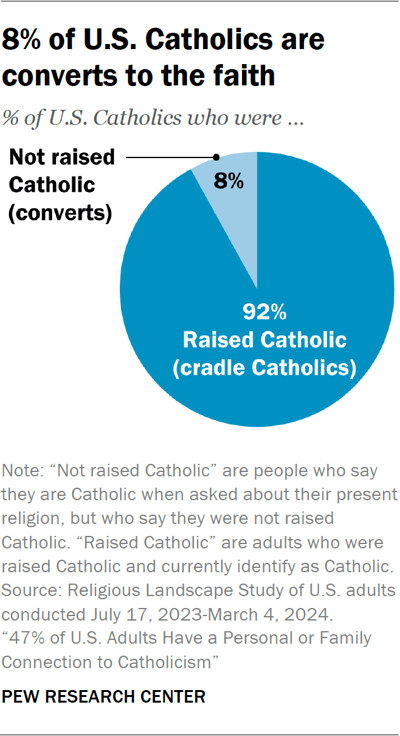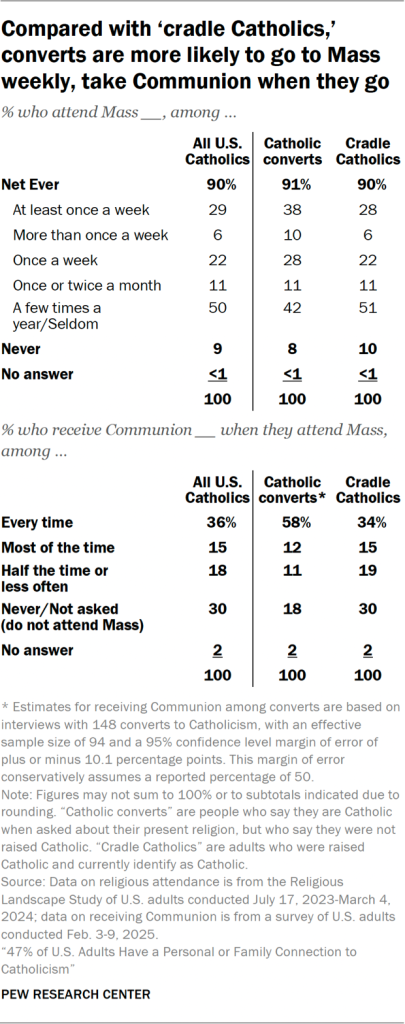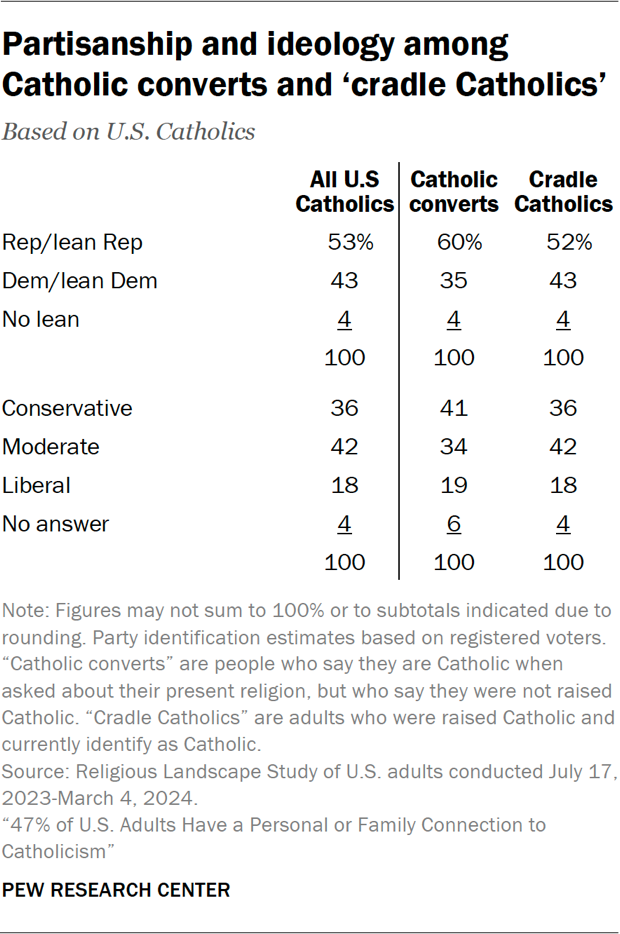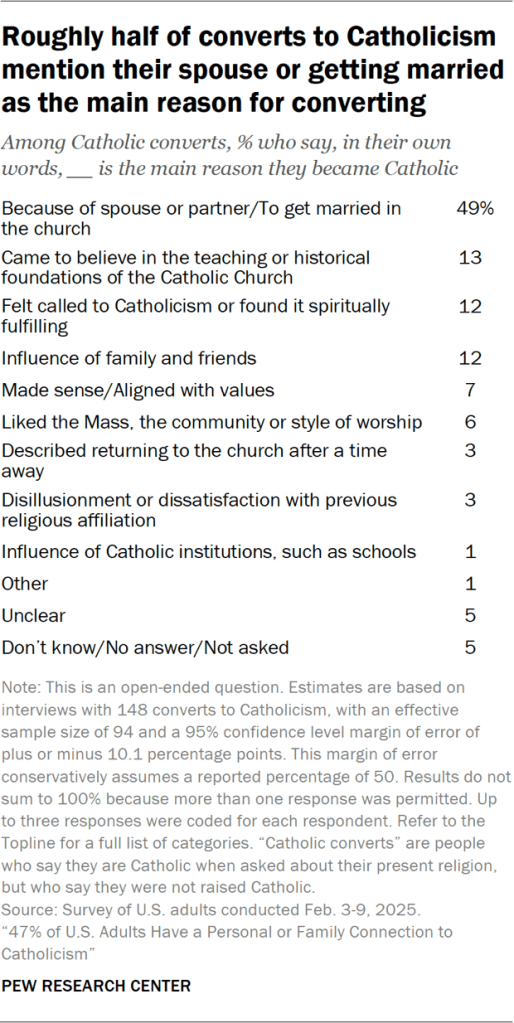In the U.S., 92% of Catholics are “cradle Catholics” – people who say they were raised Catholic and also say they are Catholic when asked about their religion today. The remaining 8% are converts to Catholicism – people who say their religion is Catholicism today but that they were not brought up Catholic.14 Overall, 1.5% of all U.S. adults are converts to Catholicism.

On average, converts to the faith attend Mass weekly at somewhat higher rates than cradle Catholics. Higher shares of converts than cradle Catholics also say they receive Communion every time they attend Mass.
But the percentages of Catholics who say they pray daily and go to confession at least once a year are similar among converts and cradle Catholics. And the share of converts who say they have attended a Traditional Latin Mass in the last five years is not much different from the share of cradle Catholics who say this (18% and 13%, respectively).
Politically, converts are somewhat more Republican than cradle Catholics and are about as likely to describe themselves as conservatives, ideologically.
When asked why they became Catholic, the most common response offered by converts is because of a spouse, or to get married in the church. Others say becoming Catholic aligned with their values or that Catholicism made sense to them.
The rest of this chapter looks at deeper comparisons of Catholic converts with cradle Catholics. Our analysis includes results from both the 2023-24 Religious Landscape Study (RLS) and Pew Research Center’s survey of Catholics conducted Feb. 3-9, 2025. The RLS has a larger sample size than the 2025 survey, and so on questions where we have data from both, we use the RLS. That said, the 2025 survey includes a number of questions about Catholicism that were not asked as part of the RLS.
Converts to Catholicism represent a small group in the broader U.S. public (1.5% of U.S. adults), and so both the RLS and the 2025 survey have relatively modest samples of members of this group. The RLS includes 662 interviews with converts to Catholicism, and results based on this group have a margin of error of plus or minus 5.5 percentage points. The 2025 survey of Catholics includes 148 interviews with converts to Catholicism, and results based on this group have a margin of error of plus or minus 10.1 percentage points.
Read about the following on Catholic converts:
Religious practices among converts to Catholicism
About four-in-ten converts to Catholicism (38%) say they attend Mass at least once a week, which is somewhat higher than the share of cradle Catholics who say this (28%). Converts also are more likely than cradle Catholics to say they receive Communion every time they go to Mass (58% vs. 34%).

However, the shares of converts and cradle Catholics who say they pray every day are similar. (The gap between the 56% of converts who say this and the 51% of cradle Catholics is not statistically significant.)

And there is little evidence that attending the Traditional Latin Mass (TLM) is more common among converts than among cradle Catholics. Among converts, 18% say they have attended a TLM at least once in the last five years, which is similar to the 13% of cradle Catholics who say the same. (The difference is not statistically significant.) Large majorities of both groups say they have not been to a TLM in the last five years.
Converts and cradle Catholics also report going to confession at similar rates. Large majorities in both groups say they go to confession less than once a year or not at all.
Demographics of converts to Catholicism
Roughly two-thirds of converts to Catholicism in the United States are White (67%) and 20% are Hispanic. By comparison, the population of cradle Catholics in the U.S. includes a smaller share of White people (53%) and more Hispanics (37%).
About six-in-ten converts to Catholicism were raised as Protestants (59%), while 22% were raised with no religion.15 The remainder were raised in other religions or declined to answer the question about their childhood religion.

Politics of converts to Catholicism
Among Catholic registered voters, converts to Catholicism are a bit more likely than “cradle Catholics” to describe themselves as Republicans or to lean toward the Republican Party (60% vs. 52%)
There is little difference between the share of Catholic converts and cradle Catholics who describe their political views as conservative. (The difference between the 41% of converts who are conservative and the 36% of cradle Catholics is not statistically significant.)

Why converts joined the church
To better understand why they joined the Catholic Church, Catholic converts were asked an open-ended question: “Just in your own words, what is the main reason you became Catholic?”

By far the most common response was that the decision was driven by their spouse or partner being Catholic. Nearly half of responses (49%) referenced this as a reason, saying things like, “married into a Catholic family” or “I married a Catholic and became Catholic after that time.”
Other common responses converts give for having joined the church include:
- Coming to believe in church teachings or in the church’s historical foundation (13%)
- Feeling called to Catholicism, or finding it spiritually fulfilling (12%)
- The influence of relatives and friends (12%)




